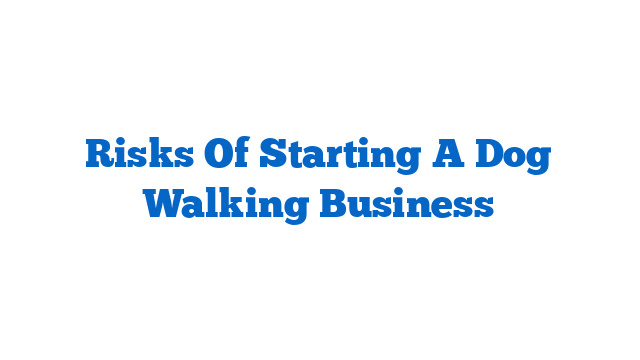
Risks Of Starting A Dog Walking Business
Introduction
Starting a dog walking business can be an exciting venture for animal lovers and entrepreneurs alike. However, like any business, it comes with its own set of risks and challenges. It’s crucial to be aware of these potential risks so that you can take appropriate measures to mitigate them and ensure the success of your dog walking business.
1. Inadequate Experience or Knowledge
One of the biggest risks of starting a dog walking business is not having sufficient experience or knowledge about handling different dog breeds and their specific needs. It’s important to educate yourself about dog behavior, basic training techniques, and how to handle emergencies to provide a safe and reliable service.
2. Lack of Insurance Coverage
Accidents can happen even with the most well-trained dogs. If a dog you’re walking bites someone or causes property damage, you may be held liable. Without proper insurance coverage, you may have to bear the financial burden of legal expenses and potential settlements. Obtaining comprehensive liability insurance is crucial to protect yourself and your business.
3. Dog Health and Safety Concerns
Ensuring the health and safety of the dogs in your care is paramount. Dogs may have pre-existing health conditions or exhibit unpredictable behavior, which can pose risks both to themselves and others. Regularly updating vaccinations, having a plan for emergencies, and using proper safety equipment are essential to minimize any potential risks.
4. Regulatory Compliance
Starting a dog walking business often requires adhering to various regulations and obtaining necessary licenses or permits. Failure to comply with these legal requirements can result in fines or the closure of your business. Research and understand the local laws and regulations governing dog walking businesses in your area to avoid any legal complications.
5. Competitive Market
Starting a dog walking business in a highly competitive market can be challenging. Established dog walking services may already have a loyal customer base, making it difficult for new businesses to attract clients initially. It’s important to differentiate your services by offering unique benefits, such as personalized care, additional pet services, or flexible scheduling, to stand out from the competition.
6. Weather Conditions
Weather conditions can impact your ability to provide consistent dog walking services. Extreme temperatures, heavy rain, or snowstorms can make it unsafe for dogs and walkers to be outside. It’s crucial to have backup plans in place, such as rescheduling walks or providing indoor exercise options, to ensure the well-being of the dogs and maintain customer satisfaction.
7. Physical Demands and Workload
Running a dog walking business requires physical stamina and the ability to handle multiple dogs at once. Walking, controlling, and caring for dogs of different sizes and energy levels can be physically demanding. It’s important to assess your physical capabilities and set realistic limits on the number of dogs you can handle to avoid injuries to yourself or the dogs.
8. Financial Instability
During the initial stages of your business, you may face financial instability due to limited clients or unexpected expenses. It’s crucial to have a well-planned budget and financial backup to sustain your business during slow periods. Additionally, offering competitive pricing while covering your costs can be challenging, so careful financial management is essential.
Conclusion
While starting a dog walking business can be a rewarding opportunity, it’s important to understand and mitigate the risks involved. By gaining knowledge and experience, obtaining proper insurance coverage, complying with regulations, and offering unique services, you can overcome these challenges and build a successful and thriving dog walking business.
FAQs about Risks Of Starting A Dog Walking Business
1. Are there any certifications or qualifications required to start a dog walking business?
While certifications are not mandatory in most places, having relevant qualifications or certifications, such as pet first aid or dog training, can enhance your credibility and give potential clients peace of mind.
2. How can I ensure the safety of the dogs in my care?
Ensuring the safety of dogs involves conducting thorough assessments of their behavior, providing proper leashes and harnesses, and implementing appropriate control measures. Regular training and keeping up to date with veterinary care are also essential.
3. What are some effective marketing strategies for a dog walking business?
Utilizing online platforms, such as social media and specialized dog service directories, can help you reach your target audience. Additionally, offering promotional deals, partnering with local pet stores, or providing referral incentives can attract new clients.
4. How can I handle unexpected situations, such as dog fights or injuries, while dog walking?
It’s crucial to have a well-prepared emergency plan that includes knowing nearby veterinary clinics, having a first aid kit, and being trained in basic pet first aid. Knowing how to handle dog fights and diffusing potentially dangerous situations is also important.
5. Is it advisable to hire employees or work as a solo dog walker?
Whether to hire employees or work alone depends on various factors, such as the size of your business and your ability to manage a team. Hiring employees can allow you to expand your business, but it also comes with additional responsibilities and costs.















Discussion about this post